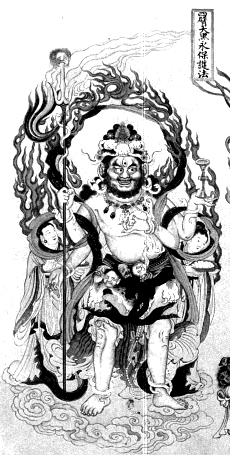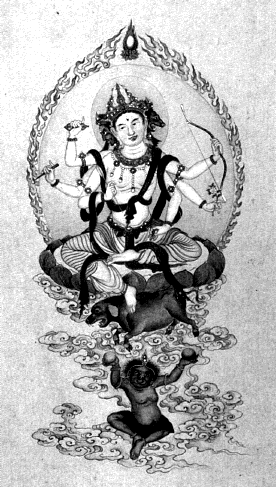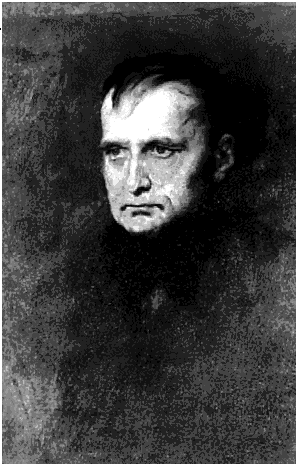Buddha
Scroll
Introduction by
Thomas Cleary
(Shambhala)

Oops. This Da Li is the kingdom of the Yunna Province that it existed from 937 to 1253. The original scroll came from the hand of one Zhyang Shengwen, in 1180. Over the years, it fell on hard times, so 500 years later, it was re-reproduced: and that's what we have here --- a Pop-Up Life of Buddha.
It's filled with hundreds of colorful characters: women with sixteen arms, demons with three faces and flaming hair, dancing doggies and piggies, saints in tree trunks, nursing women, sleeping boys, laughing reindeer, wild birds, and a wonderful grumpy old man with six arms, bow and arrow, four legs, in the lotus position, surrounded by flames --- all resting neatly on the back of a testy water buffalo.
 Along with the scroll is a black-and-white reproduction with key, telling us, for example, that our fiery friend is "The Great Victorious Diamond Borer." In the center, or near the center of this wonderful lineage, is Buddha himself, at position #31, surrounded by a bevy of clouds and lotus leaves, "The Shakyamuni in a Giant Jewel Lotus," right hand up, third finger bent, benign face, those notoriously long ear-lobes. And off to the left, his "congregation" --- including some of the most alarming looking holy men, looking like they'd bite you if you messed with them; snarling, we suppose, with delight, at being so close to the master.
Along with the scroll is a black-and-white reproduction with key, telling us, for example, that our fiery friend is "The Great Victorious Diamond Borer." In the center, or near the center of this wonderful lineage, is Buddha himself, at position #31, surrounded by a bevy of clouds and lotus leaves, "The Shakyamuni in a Giant Jewel Lotus," right hand up, third finger bent, benign face, those notoriously long ear-lobes. And off to the left, his "congregation" --- including some of the most alarming looking holy men, looking like they'd bite you if you messed with them; snarling, we suppose, with delight, at being so close to the master.
And you know why his ear-lobes were so pendulous, don't you? The story is, that when he was meditating, and when he felt himself about to drift off, he would yank on his ears to keep himself awake. Thus you now know that all good Buddhists have earlobes that droop down to their shoulders.
Roads
Adventures from the
Pilgrimage Trail
Nicholas Shrady
(Harper/San Francisco)
No, he actually walked around Medjugorje, Bosnia, where the five kids talk to the Virgin Mary on a regular basis. He took thirty days to go, on foot, in the winter, from the French border to Santiago de Compostela.
He went to the source of the Ganges, and then walked through some fairly dangerous areas, to the city of Varanasi. For days, on his own, he went in and around Jerusalem (getting beat up by an Israeli soldier in the process.) Finally, he found the burial place of Rumi, the great Sufi poet, and was invited to a secret ceremony of the whirling dervishes.
As he seeks the Virgin in Medjugorje, he tells us that visits from the Virgin Mary have occurred in such diverse places as South Korea, Venezuela, Damascus, as well as the more familiar Lourdes, Fatima, and Tepayac Hill. As we journey with him in India, he reads and meditates on the holy texts, and his summaries of the great Hindu texts "Himayana" and "Mahayana" are admirable. He reveals, from personal experience, that one can freeze to death travelling the five hundred miles to Santiago de Compostela, in the winter (there are also some Catholic priests who will bar their doors to you). Freebooters can and do rob you in Bihar. Whirling dervishes are illegal in Turkey. Refugees abound in Jerusalem ("If Christ were among us...he would be in the refugee camp.")
His lively descriptions and acute blend of questioning and faith makes this one of the best travel guides I have read, especially his descriptions of the upper reaches of the Ganges, and Jerusalem (one of his favorite sights is a Muslim temple at Haram el-Sharif along the Road of the Chains).
We are left with the feeling that Shrady is a true pilgrim --- for there has to be a certain humility in the pursuit of the holy, and he wastes little of our time with personal history, stories outside of his journey. He ends up being an unknown, rather mysterious. Where did he come from? What, in his life, made him decide to embark on this trail?
He proves himself an indefatigable traveller, one well worth making a holy journey with. A fit companion, indeed, for all of us --- funny, skeptical of cant, opinionated, and yet open to all that a holy journey can reveal to him, and to us.
At Longwood
Napoleon's Exile on
Saint Helena
Jean-Paul Kauffmann
Translated by
Patricia Clancy
(Four Walls, Eight Windows)
 The Encyclopedia of Military History tells us that "The first coherent new concept of warmaking to manifest itself since Genghis Khan had been demonstrated in the early campaigns of young Napoleon Bonaparte in Italy and Egypt...he fought more battles than Alexander, Hannibal, and Caesar combined." In 1811, Napoleon and his armies controlled Spain, the Rhine Confederation, the Austrian Empire, the Kingdom of Italy, Holland, Prussia, the Grand Duchy of Warsaw, Denmark and Norway.
The Encyclopedia of Military History tells us that "The first coherent new concept of warmaking to manifest itself since Genghis Khan had been demonstrated in the early campaigns of young Napoleon Bonaparte in Italy and Egypt...he fought more battles than Alexander, Hannibal, and Caesar combined." In 1811, Napoleon and his armies controlled Spain, the Rhine Confederation, the Austrian Empire, the Kingdom of Italy, Holland, Prussia, the Grand Duchy of Warsaw, Denmark and Norway.This is the man who --- for the last six years of his live --- was confined to a tiny house on a tiny rock in the south Atlantic. St. Helena Island lies 1250 miles west of Angola, 1500 miles south of the Ivory Coast, and 2500 miles east of Brazil. It's a mountain out of the sea, really --- and the trade winds blow from the northwest constantly.
After Waterloo, Napoleon was a prisoner of the English. They didn't want to make the same mistake as they had with Elba. They picked the furthermost corner of the earth, this bleak island, and shipped him there on 15 October 1815. He died there 5 May 1821.
Naturally, for one who had been at the head of such an army, had conquered so much territory, he was restless, depressed, strutting and fretting his last days on earth. He had wanted to escape to America, but he waited too long. The English made him believe that he would be retired to a rural area in their own country, to become a squire --- but then they put him in a place where there was no possible escape, in a house where the winds blew constantly, where the humidity was devastating, where the termites consumed everything, a house which they called Longwood:
This book began the very moment I entered the house. I had only to breathe the air, the odor of a damp cellar mixed with a strange tropical perfume --- the heavy, rather peppery smell that fills your nostrils as soon as you open a cigar box --- to become aware of the dimension of time on St. Helena. It's of no real importance that the exotic smell comes from the African wood in the floorboards --- the original parquet was destroyed by termites long ago. There's still a strong whiff of mildew, made a little less unpleasant by creosote, the sooty smell that comes from old fireplaces.
And then:
Captivity is first of all a smell. Napoleon had an extremely sensitive olfactory sense. "I have seen him move away from more than one servant, who was far from suspecting the secret aversion he had inspired," wrote Baron Fain, the Emperor's personal secretary from 1813.
Kauffmann has constructed a Doppelgänger. There is the St. Helena of Napoleon; and there is the St. Helena that the author visits in order to create this book. In the hands of a lesser craftsman, this could be a lunky show-off literary exercise. But Kauffmann has a fine eye, an excellent ear for phrasing, and the present and the past get intertwined --- a rare double helix of time and history and thoughts and smells.
He has so immersed himself in the last days of Napoleon that we have a work laden of facts, interesting facts --- not the nonsense with which most fake historians fill out their pages to impress us --- but rather, those key moments that reveal the past to the present, all mined with a fine delicacy.
As Napoleon dictates his memoirs to the four faithful followers, who live there in exile with him, "he ceaselessly goes over the battle plan, looks for signs, indications, mistakes that always escape him." There is the beginning of depression: "the Emperor is fighting himself. He stays in his room and will not see anyone." There is a child, who lives on the island, who comes to visit:
It is difficult to imagine that the god of battle, the thundering Jupiter, the terror of Europe, could play the fool to cheer up Betsy Balcombe and amuse himself by frightening her. He's not afraid to tousle his hair, make horrible faces, and roar like a lion.
What a picture: the terror, the Jupiter, roaring like a lion, to amuse a child.
Napoleon hated smells --- especially of people. Towards the end, he would get in his bathtub at Longwood, floating, suspended, staying for hours. And always, there were the smells:
The smell of Longwood...It was an obsession of the Emperor's. He had had to prolong his stay at the Briars [his first house on St. Helena] because of the fresh paint. He couldn't stand the slightest whiff of it.
The smells, the atmosphere, the history. So many portrait painters tried to capture him, yet none of them were able, it is said, to reproduce his startling face. In the morning, when they first came to his room, none of his entourage spoke until he spoke first. His memoirs, dictated to four of them (for the four fields of battle) are dry, filled with dates and time, with none of the noise, none of the improbable adventure of a man who terrified Europe for fifteen years, a man who had ranged through Spain, Egypt, all the way up to the gates of Moscow --- now in a cottage with four rooms, a billiards table, and the wind, the constant wind.
It's a mix we have here in The Black Room at Longwood. The island now, as always, so distant from the world. There is no television. Everything is imported from England. The locals --- called "Saints" --- are indifferent to the history, to their most famous inhabitant. Their conversations with Kauffmann at times border on the churlish. "Now explain to me why you're so keen on this character," one of them says. "You're really obsessed by Napoleon. You're tracking him." So much they miss in their tiny --- obviously boring --- present, the 6,000 saints. They cannot conceive of one fascinated by this fascinating person from 200 years ago.
But he is... is so very fascinating, strange; and in his last days, so melancholic --- there at Longwood, captured, and captured so well, by a writer who has the magic ability to turn the exile into a study of a rich, claustrophobic past, mixed with a dry, claustrophic present: the people of an island, who are in the midst of their own exile, both physical and mental.